#george telegraph accounts course
Explore tagged Tumblr posts
Photo

Top Professional Diploma in Finance and Accounts in Kolkata | George Telegraph
If your are looking for the best diploma course in financial accounting in kolkata then visit George Telegraph Training Institute today. We provide 100% placement assistance.
https://www.georgetelegraph.com/accounts-and-finance-department.aspx
#george telegraph institute of accounts#accounting and finance training institute#george telegraph accounts course#accounting and finance course in kolkata#diploma in financial accounting#financial accounting course in kolkata#accounting and finance certifications courses#professional courses in finance and accounting#advance excel training institute in kolkata#diploma course in financial accounting#professional diploma in finance and accounts
0 notes
Text

Best Professional Business Accountant Course in Kolkata
If you are looking for the best business accounting course in Kolkata then visit GTIA. GTIA provides the best Professional Business Accountant course program which is designed to give you the qualifications you need to succeed. Join now.
#accounting certificate programs near me#professional business accountant course in kolkata#online accounting certificate courses#george telegraph institute of accounts#accountant course#business accounting course#professional accountant course#accounting course#professional business accountant#accounting professional courses#accountant training courses
0 notes
Note
Perhaps I am biased as he is one of my favourites but do you have any theory on why George Russell [if you are interested that is] seems get such a rough ride with press.
As far as I know, he doesn't do anything particularly problematic, he seems pretty low key when he's not at races and just genuinely seems to life his life with his partner. As yet there has been no scandal from his personal life. I can see that his on track brand might have been dampened from his years at the back with Williams. But his time so far at Mercedes don't seem to have helped either, last year he got so much abuse from fans, and the most seem to be from his teammates fans. For years now people have called him a Tory [the slang word for the right wing Conservative Party in the UK] and PR63, like all drivers don't have to do press? Huge double standards seems to exist for George, and not the other drivers.
Okay so a bit late but I do think I may be able to help a bit upon further thought! I have a few ideas, so this will be an essay format. This is a bit of a complicated PR case because particularly stuff with the press is less about him as you will see, and is largely for the mean time out of his control:
Firstly, British drivers often occupy a place of contention in the sport whether they initially annoyed people or otherwise. I am sure you have long heard people say things like British bias but it actually goes beyond people talking about British media, and also goes into the longheld association of Britain, with the birth of F1, with many also calling it the "home" of F1. For drivers like George in specific, (British, White, Male), there is a kind of assumption even from non-English media, that in every generation of F1 drivers, you will see someone like George at the front of the pack, being considered a serious WDC contender.
So even back in Williams, where he was thought to be a backmarker car, he was a major topic of conversation, which bred a lot of resentment. But the point of the matter is that PR wise, British drivers especially the ones that are not marginalized in the way that Lewis are (although people do also say British bias about him), are always sort of a press focus, even outside of anglophone media.
I am sure since you're a George fan, you have seen conversations and sometimes arguments about who between George and Lando will be the next great British driver, and who is most likely to succeed Lewis, but you don't see Alex Albon in the media despite the fact that he was once in an RBR seat. You also don't see a lot of fanfare in the racer capacity around people like Susan Wolff.
There also is the assumption in and of itself that (white male) British drivers are something of a dynasty that often rubs fans the wrong way. So on that part, it is largely out of George's control, because white male British drivers like him and Lando will always be seen as "establishment" especially to older fans of the sport that have watched since prior to F1 having a growing presence on social media. Drivers have "always" been like him and Lando, engineers have been like him and Lando, media have been like them, etc. To date the UK is home to a lot of F1 related business, so it has the PR of not just heritage, but also establishment. And of course whilst him and Lando are very different, with Lando even writing in a paper nicknamed the torygraph (Thats the telegraph for those of you unaware), that aspect of his image is less about *him* and more about what he is believed to represent.
The other thing to take into account is that Williams for a long time was PR wise seen as a British family business, with a heritage to boot. When British drivers leave teams associated with British identity like McLaren and Mercedes, it often leads to anger from the British public like when Lewis left McLaren years back so that also meant for him that there is resentment from establishment fans who considered Lewis to be unpatriotic or unBritish for leaving (and incidentally is also a strand of anger that still exists today about Lewis "leaving a British team"). That being said, in DTS there was a lot of emphasis on Williams as a struggling British family endeavor and following the various seasons of DTS George was often accused of being self absorbed and not being able to be a team player. So that was another part of it.
The last aspect is that the people from the previous paragraph that would be considered "establishment" supporters, don't like Mercedes because they consider it to be a company that is the antithesis of traditional motorsports, with diversity initiatives and so on. But unlike a couple of years prior, seeing those things as negative would draw criticism, so its sort of been hidden behind this thing of "Mercedes is too PR". Mercedes has long been accused of being overly concerned with its PR and branding, and you see both former and current drivers being accused of saying things for the purposes of PR.
Lando not being accused of PR is less about him not doing or having PR (Lando absolutely does, like every other driver, regardless of what fans are led to believe based on branding), and more of him benefitting from McLaren formerly having a PR image as this British for the Family team that's just about racing and not overly calculated. And of course you're starting to see the fall out of that image collapsing but I will save that for my McLaren essay. In George's case he is in a team that has an image of a certain kind of sophistication and a push towards the kinds of initiatives that some sections of F1 do not like.
It is definitely a complicated PR conundrum because the primary causes of what he is disliked for and really about him, but what he represents and who his team is, but also, whilst people who dislike him call him a Tory and PR63, those are more so related to him being viewed as having a sort of bland and uncontroversial personality (not that he is actually bland and uncontroversial), which when it comes to athletes is often met with skepticism and suspicion that something lies underneath the surface.
Audiences, especially in F1 often have this thing especially with Vettel and Hamilton about disliking them having strong personalities, depending on who you ask also being very competitive drivers, or being vocal about their politics, but the current media climate is such that if you are not like Vettel and Hamilton, in the sense that you're considered to have a distinctive personality and expressing opinions on social issues, even the audiences that vehemently dislike that about them find it suspicious. Having a PR image that comes across to audiences as neutral is useful in the sense that there will likely never be any major PR mishaps, but it also means that audiences think that in an era of social media and the likes, especially as a younger driver, it is unusual to come across that way hence comes the sentiments that he is deliberately hiding who he is.
Overall, since he is newer at Merc, only time can tell whether being in a more visible team will benefit him in the long run as audiences will see more of him, his personality etc, or if it will continue to be an issue with audiences that are more set in their image of him. With the press because of the nature of being associated with establishment, that will always be a tricky thing to navigate PR wise. As for teammate fans, from a PR perspective that that would not be a point of concern because in a sport where your teammate is your biggest competitor, it is kind of the expected standard procedure that not all fans will be very receptive, a big example of this is Carlos and Charles, it only becomes an issue when you have explicit incidents like multi 21 or Brazil 22 where that would be a PR focal point, or matter of concern.
Let me know if you have questions about this, and I will see if I can answer!
8 notes
·
View notes
Text
Five Interesting Russian Nonfiction Books
Natasha's Dance: A Cultural History of Russia - History on a grand scale--an enchanting masterpiece that explores the making of one of the world's most vibrant civilizations. A People's Tragedy, wrote Eric Hobsbawm, did "more to help us understand the Russian Revolution than any other book I know." Now, in Natasha's Dance, internationally renowned historian Orlando Figes does the same for Russian culture, summoning the myriad elements that formed a nation and held it together. (GoodReads)
Romanov Autumn: Stories from the Last Century of Imperial Russia - The Romanov dynasty ruled Russia for a little over 300 years. The story of the dynasty's dramatic end has exerted a lasting fascination. This book seeks to widen the picture, looking at the lives of members of the family during the last century of imperial rule, and setting this into the context of the grand palaces in which they lived. It was a time of contrasts, a period in which the Tsars reached the peak of their wealth, prestige and power, yet also faced the growth of forces which would destroy them. In 1817, 100 years before the Revolution, the first Nicholas and Alexander were married in the Winter Palace. This book tells their story, and the stories of their successors, Alexander II, Alexander III and Nicholas II, each trying to steer their own course. It also looks at the lives of their sisters and brothers, and other members of the large Russian royal family, detailing their daily lives. (GoodReads)
Tent Life in Siberia: An Incredible Account of Siberian Adventure, Travel, and Survival - In the 1860s, the Russo-American Telegraph Company set out to telegraphically connect the United States and Europe using lines running through the Bering Straits and Siberia. The failed expedition marked one of the first explorations of the vast Siberian wilderness, and George Kennan’s tale of a seemingly endless land filled with wildlife and nomadic tribes is as entertaining today as it was 140 years ago. With biting humor and poignant insight, Kennan details his years fighting to survive a doomed mission. He depicts the quiet loneliness of the desolate landscape, the eerie glow of the sun at midnight, and the refusal to give in to one of the harshest places man has ever tried to conquer. His book is a testament to our planet’s beauty and danger, as well as to the tireless will of the human spirit. (GoodReads)
Moscow Nights: The Van Cliburn Story-How One Man and His Piano Transformed the Cold War - Gripping narrative nonfiction that tells the dramatic story of a remarkable young Texan pianist, Van Cliburn, who played his way through the wall of fear built by the Cold War, won the hearts of the American and Russian people, and eased tensions between two superpowers on the brink of nuclear war. In 1958, an unheralded twenty-three-year-old piano prodigy from Texas named Van Cliburn traveled to Moscow to compete in the First International Tchaikovsky Competition. The Soviets had no intention of bestowing their coveted prize on an unknown American; a Russian pianist had already been chosen to win. Yet when the gangly Texan with the shy grin began to play, he instantly captivated an entire nation. The Soviet people were charmed by Van Cliburn’s extraordinary talent and fresh-faced innocence, but it was his palpable love for the music that earned their devotion; for many, he played more like a Russian than their own musicians. As enraptured crowds mobbed Cliburn’s performances, pressure mounted to award him the competition prize. "Is he the best?" Soviet Premier Nikita Khrushchev demanded of the judges. "In that case . . . give him the prize!" Adored by millions in the USSR, Cliburn returned to a thunderous hero’s welcome in the USA and became, for a time, an ambassador of hope for two dangerously hostile superpowers. In this thrilling, impeccably researched account, Nigel Cliff recreates the drama and tension of the Cold War era, and brings into focus the gifted musician and deeply compelling figure whose music would temporarily bridge the divide between two dangerously hostile powers. (GoodReads)
On a warm July evening in 1985, a middle-aged man stood on the pavement of a busy avenue in the heart of Moscow, holding a plastic carrier bag. In his grey suit and tie, he looked like any other Soviet citizen. The bag alone was mildly conspicuous, printed with the red logo of Safeway, the British supermarket. The man was a spy for MI6. A senior KGB officer, for more than a decade he had supplied his British spymasters with a stream of priceless secrets from deep within the Soviet intelligence machine. No spy had done more to damage the KGB. The Safeway bag was a signal: to activate his escape plan to be smuggled out of Soviet Russia. So began one of the boldest and most extraordinary episodes in the history of spying. Ben Macintyre reveals a tale of espionage, betrayal and raw courage that changed the course of the Cold War forever... (GoodReads)
2 notes
·
View notes
Text
A Comprehensive Guide To Understanding GST And Its Implications
George Telegraph Institute of Accounts is a leading training provider in India, offering comprehensive courses on GST compliance and accounting. Their courses are designed to provide practical training on GST, helping businesses stay compliant with the GST laws and regulations.
Learn More:https://eduguide.co.in/a-comprehensive-guide-to-understanding-gst-and-its-implications/

0 notes
Photo
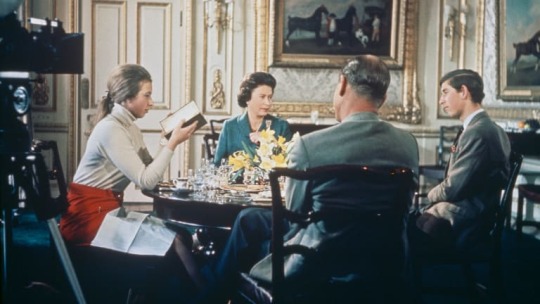
Once you touch the trappings of monarchy, like opening an Egyptian tomb, the inside is liable to crumble.
- Anthny Sampson
The concept behind the documentary was to soften and modernize the royal image. But members of the royal family, including the Queen, were reportedly dubious about the idea from the start. After its premiere, Buckingham Palace greatly limited the film’s circulation, at least in its entire form.
It was Lord Brabourne, the son-in-law of the royal cousin Lord Mountbatten, who suggested using the medium of television to provide the Queen’s subjects a sense of her personality. By the 1960s, the times were rapidly changing, and the shy, dutiful Queen and her young family were seen as increasingly irrelevant. A TV special, Brabourne suggested, could also introduce British subjects to 21-year-old Prince Charles, ahead of his investiture as Prince of Wales.

At the urging of Palace press officer William Heseltine, who was convinced that offering a humanized view of the royal family would strengthen the monarchy, Prince Philip agreed. The Queen cautiously gave her consent, while other family members were decidedly not on board.
“I never liked the idea of 'Royal Family,' I thought it was a rotten idea,��� Princess Anne later recalled, according to an account in the 2015 book, Queen Elizabeth II and the Royal Family. “The attention which had been brought upon one ever since one was a child, you just didn’t need any more.”
But the Mountbatten camp won the day and filming began in 1968. Richard Cawston, the chief of the BBC Documentary unit, was put in charge of shooting the royals at work and play. For months, he shot 43 hours of unscripted material at Buckingham Palace, Windsor Castle, on the royal yacht, the royal train, and even at the Queen’s beloved Balmoral Castle in Scotland.
Understandably, the royal family had a difficult time adjusting to the presence of the crew in their personal space. Peter Conradi writes in his 2012 book, Great Survivors: How Monarchy Made it into the Twenty-First Century, that during a film day at Balmoral, Philip snapped at the crew, “Get away from the Queen with your bloody cameras!”
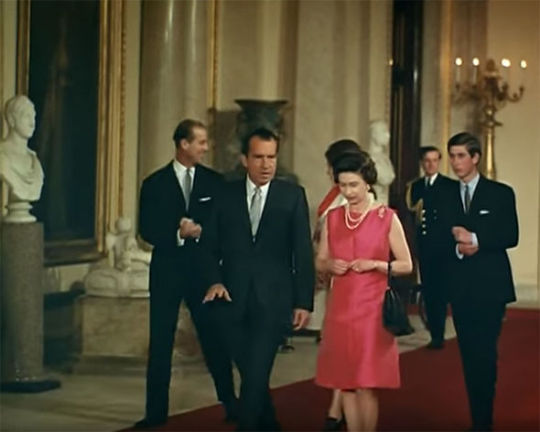
The finished documentary claimed to show a year in the life of the royal family. Queen Elizabeth was featured tirelessly working and making small talk with world leaders like U.S. President Richard Nixon. During his state visit, she asked him, “World problems are so complex, aren't they, now?” To which Nixon replied, “I was thinking how really much more complex they are than when we last met in 1957.”
There were also sweet scenes, like one where the Queen takes her youngest son, Edward, to a candy store, paying for his treats herself even though the monarch is technically never supposed to carry money.
The royal family’s genuine sportiness was also highlighted - Prince Charles was shown waterskiing and fishing, Prince Philip flew an airplane and the Queen drove her own car surprisingly fast.
But there were also strained moments, according to detractors. At one point Prince Philip describes an instance when King George VI the Queen Mother’s late husband, took out his rage with a pruning knife on a rhododendron bush, screaming curse words while hacking it to bits. “He had very odd habits,” Philip deadpanned. “'Sometimes I thought he was mad.”
Then there was when Queen Elizabeth jokes: “How do you keep a regally straight face when a footman tells you: "'Your Majesty, your next audience is with a gorilla?... It was an official visitor, but he looked just like a gorilla.”

Cawston let Philip see a rough cut of the documentary before showing it to the Queen. “We were all a little bit nervous of showing it to the Queen because we had no idea what she would make of it,” the film’s editor Michael Bradsell told the Smithsonian channel in a 2017 special. “She was a little critical of the film in the sense she thought it was too long, but Dick Cawston, the director, persuaded her that two hours was not a minute too long.”
The public was, in fact, intrigued—more than 30 million viewers in Britain alone viewed the premiere. It was said that during an intermission, toilets flushed all over London, causing a water shortage.
Less than a month later, on July 1, Prince Charles was invested at Caernarvon Castle in a carefully filmed spectacle organized by the photographer Lord Snowdon, Princess Margaret’s soon to be ex-husband.
This double-whammy of royal TV was seen by some as a rousing success. “It redefined the nation's view of the Queen,” Paul Moorhouse, former curator of the National Portrait Gallery, told Daily Telegraph in 2011. “The audience were amazed to be able to hear the Queen speaking spontaneously, and to see her in a domestic setting."
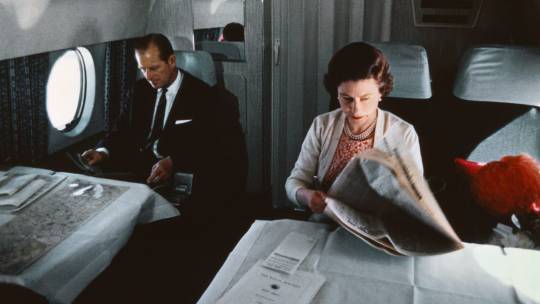
But to many, the royal family had opened Pandora’s box, lifting the veil and making them easy targets for criticism and intrusive paparazzi activity.
"They were criticized for being stuffy, and not letting anybody know what they were doing, and my brother-in-law helped do up a film, and now people say, 'Ah, of course, the rot set in when the film was made,’"royal cousin Lady Pamela Hicks and daughter of Lord Mountbatten told an interviewer. "You can't do right; it's catch-22."
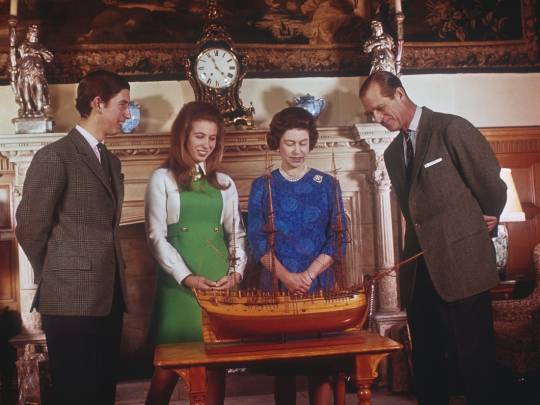
"Royal Family" was shown only once more in full, in 1977. And in 2011, Buckingham Palace gave the National Portrait Gallery a 90-second clip of the breakfast scene during the Diamond Jubilee celebration. The palace allowed a few more brief clips to be included in the 2011 documentary "The Duke at 90."
#anthing sampson#quote#monarchy#royalty#britain#queen#queen elizabeth II#elizabeth II#duke of edinburgh#queen mother#prince charles#princess anne#royal family#documentary#history#culture#society#british
52 notes
·
View notes
Text
Submitted: Telegraph - Camilla Tominey
How Kate’s candid camera is killing off the paparazzi
Duchess of Cambridge’s release of family photos has destroyed the market for shots that can be sold
ByCamilla Tominey,
ASSOCIATE EDITOR24 June 2020 • 7:00pm
Kate Middleton has been providing striking images of life behind palace gates CREDIT: Aaron Chown/PA
This article first appeared in Your Royal Appointment, our weekly royals newsletter. Exclusively for subscribers, each newsletter includes a new column from Camilla Tominey, as well as all the latest royal updates. You can sign up via the My Newsletters section of My Account.
The Duchess of Cambridge’s Royal Family album is fast rivalling Patrick Lichfield’s.
Over the past few days, royal-watchers have been treated to some extraordinary images of life behind palace gates.
As well as photographing William larking about with their three children to mark his 38th birthday on Sunday, Kate also managed to capture a touchingly tender moment between two future kings.
Showing Charles affectionately resting his head on William’s shoulder, huge smiles on both their faces, her picture could not be further removed from the stuffy royal portraiture of the past.
The Duchess of Cambridge’s picture of Charles and William CREDIT: The Duchess of Cambridge/Kensington Palace
Yet what is even more remarkable than Kate’s flourishing artistry is the effect it has had on royal photography in general. Releasing such intimate family photos so regularly to the press has killed, stone dead, the market for paparazzi shots.
Why would any newspapers or magazines want to run grainy long-lens images of the royals in private when they themselves are willing to serve up crystal clear Instagram-style shots?
Diana, the late Princess of Wales, could only have dreamed of such a scenario. And when you consider how fiercely protective William is of his family’s privacy, you soon realise this is no accident.
As I first wrote in 2013, this unique form of royal image control has all been by design. At that time, I noted that Kate, then pregnant with Prince George, had been taking a close interest in the way European royals were managing the media with regard to photography of their children.
Conscious that the public would demand to see “at home” imagery of George – and later Princess Charlotte and Prince Louis – but anxious not to thrust them into the limelight, the Duchess borrowed an idea from Victoria, the Crown Princess of Sweden.
The Duchess’s snap of William with Prince George, Princess Charlotte and Prince Louis CREDIT: The Duchess of Cambridge/Kensington Palace/AFP
Having grown up to be mistrustful of the press after they reported details of her anorexia when she was a teenager, Sweden’s queen regnant resolved to do things differently when her first child, Estelle, was born a year before George in 2012.
She swiftly began releasing her own photographs of the baby to ensure that any imagery of Estelle was released on her own terms. The public reacted hugely positively, loving not only the fact that they could see such milestones as Estelle blowing out the candles on her first birthday cake but also that Victoria was behind the camera.
Already a keen amateur photographer – a hobby encouraged by her father, Michael Middleton – Kate decided she would do the same, rather than always relying on the services of a professional photographer.
Kate’s interest in photography was encouraged by her father, Michael Middleton CREDIT: The Duchess of Cambridge/Kensington Palace/AFP
Of course there still is, and always will be, a place for experienced lensmen and women to capture the big royal moments. However, it has always been these more candid camera shots that the public has craved.
I know experts may have an opinion on Kate’s focus, use of lighting and so on, but when it comes to seeing the “real” royals behind their public personas, the Duchess is fast becoming the monarchy’s leading chronicler of modern royal life.
——————————————— So Kate realised that controlling the pictures would be the death of the long lens pap shot? Do you think that Markle wanted to control it even more and make money re pregnancy and birth?
______________________________________________________________________
Thanks for sending this in! How long have we been arguing that the brf should emulate the Swedes? Years, at least. I’m glad they finally saw the light.
Meghan’s situations is different. She doesn’t want to kill the pap market with free pics. She wants to be paid for pics of her kid.
92 notes
·
View notes
Photo
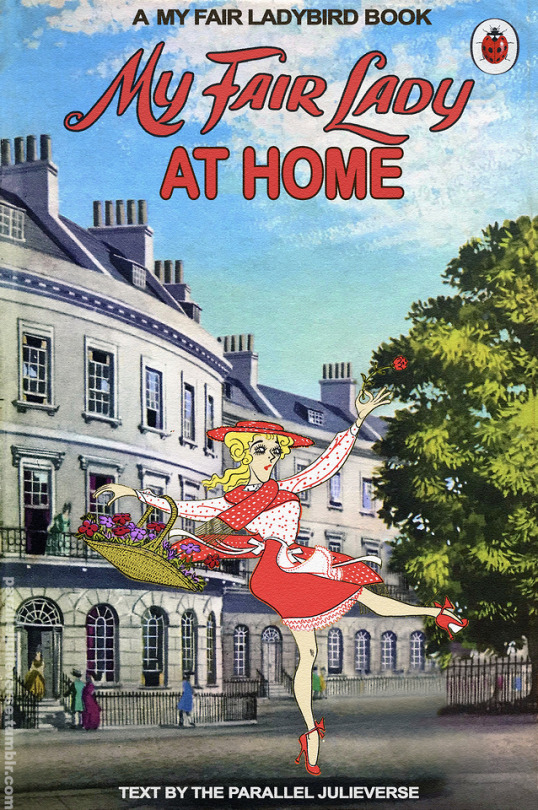
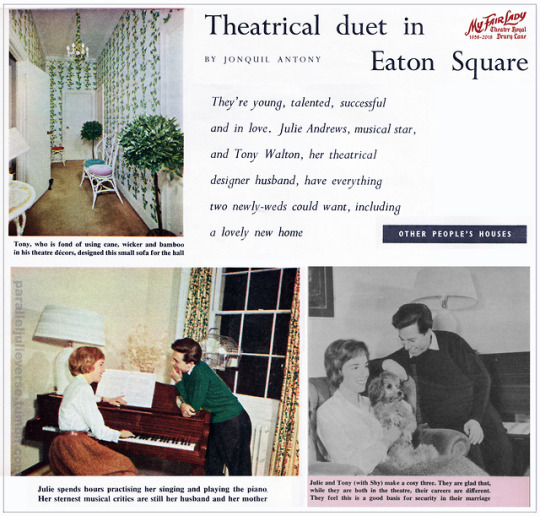

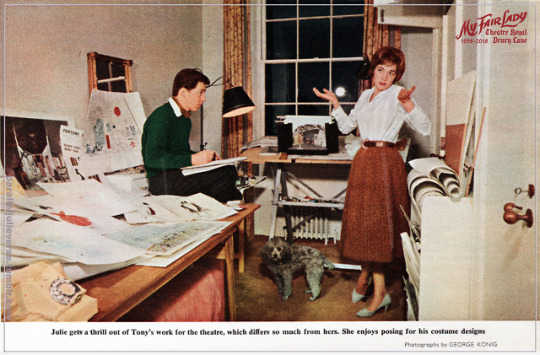
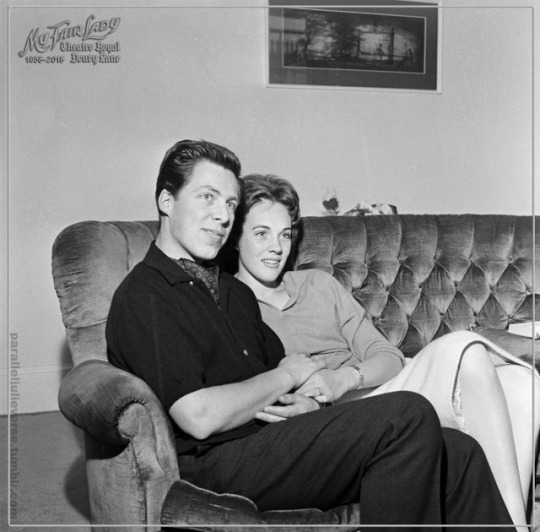
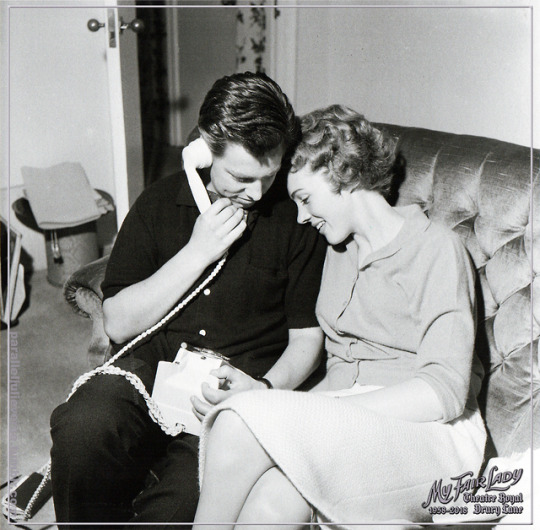
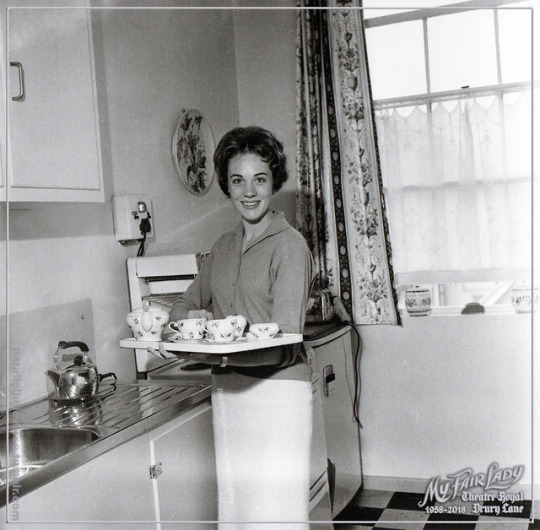
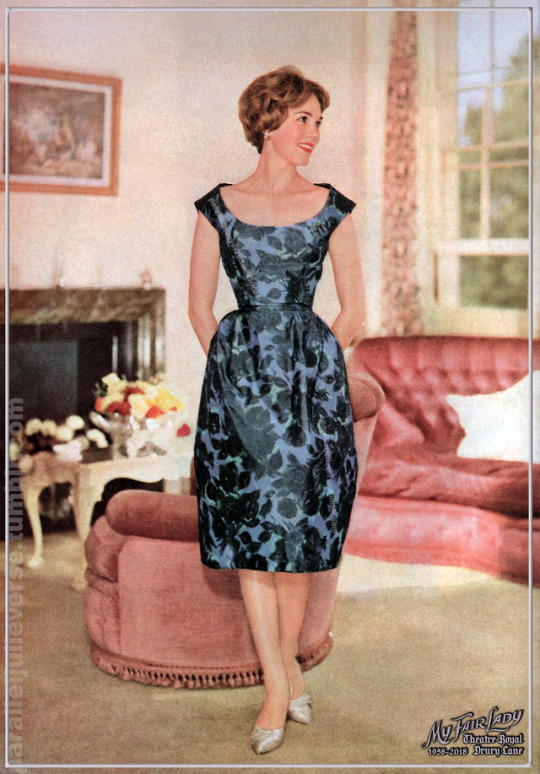
Following our recent posts marking the 60th anniversary of the wedding of Julie Andrews and Tony Walton, here we shine a brief spotlight on how the newlyweds were covered by the media in the early years of their marriage. Their May 1959 wedding was a definite high-water mark of media exposure for Julie and Tony but public interest didn’t end once they’d walked down the aisle. Newspapers and magazines continued to feature regular stories and photos about the ‘happy couple’, detailing what they were up to and how they were adapting to life as husband-and-wife.
Much of the coverage presented the newlyweds as a quintessentially modern couple who were combining the twin demands of dual careers with companionate marriage. A multi-page profile in the January 1960 issue of British women’s magazine, Housewife serves a good case-in-point. Essentially a ‘celebrities at home’ pictorial, the article marshals the couple’s “delightful new home––a large flat overlooking Eaton Square––to which they went when they were married eight months ago” as a symbolic expression of the blended amalgamations of marital domesticity (Antony: 38).
The “Andrews-Walton flat is a combination of their two careers,” the article chirps, “Julie’s piano has a prominent place and one room is made into Tony’s studio��� (Antony: 40). Elsewhere it describes a cosy everyday scenario of domestic give-and-take as “Julie spends hours practising her singing” with Tony acting as one of her “sternest musical critics,” while Julie in turn “gets a thrill out of Tony’s work for the theatre [and] enjoys posing for his costume designs” (38-39). The image painted here is a transactional blend of conventional married home-life with newer forms of egalitarian coupledom: “two young people––both so young and in love––embarking on a duet” in “their lovely new home...a good basis for security in their marriage” (40-41).
Other profiles were considerably less blithesome. A recurrent refrain in a lot of the media coverage of Julie and Tony’s marriage was the perceived challenges faced by a couple in which, as one early newspaper report put it, “the wife’s name has embarrassingly eclipsed the husband’s” (Wilson: 10). In an era still tethered to orthodox notions of male breadwinners and female homemakers, a union in which the wife assumed greater professional and financial prowess than the husband was sufficiently novel to evoke both curiosity and, at times, unease.
In the newspaper profile just mentioned, Cecil Wilson (1959) strikes a note of thinly-veiled anxiety when discussing what he apprehends as a gendered dilemma in the couple’s marriage. Titled “How Not to Be Known as Mr Julie Andrews”, the article asserts a very traditional view of marriage in terms of masculine dominance and feminine support. “No man could have done more in less time” than Tony Walton, it proclaims, “to rise above the reflected glory of being ‘Julie Andrews’s husband’ or, worse still, the ignominious label of ‘Mr. Julie Andrews’” (10). “Since his childhood sweetheart from Walton-on-Thames consolidated her...stardom in My Fair Lady, he has firmly established the name of Tony Walton by designing four West End shows...[and n]ow, to give Julie Andrews further pride in being known as Tony Walton’s wife, he has gone into management” as a theatre producer (ibid.).*
It is a testament to Julie and Tony’s fortitude and well-grounded emotional security that, for the most part, they deflected such concerns as immaterial. Responding to a reporter’s question about how her status as “one of the country’s wealthiest young actresses” impacted her new married lifestyle, Julie demurred: “I don’t know how much I’m worth...We haven’t a car, although I hold a licence. But Tony holds the important licence, the marriage one” (Hickey: 3). Later, on the eve of her departure for New York to start rehearsals for Camelot, Julie mused further on the ambivalent demands of career and marriage: “Of course it’s nice to get back to work. I love the stage. But what I really like and what I want to do is to settle down and be plain Mrs. Walton” (Tanfield: 12).
For his part, Tony Walton struck a particularly mature and, for the time, progressive attitude to the unorthodox dynamics of his and Julie’s marriage. When asked in a 1959 interview if he experienced “professional jealousy” of Julie, he replied with categorical pragmatism: “Not a bit. After all, Julie has one career and I have another. But I still wouldn’t rank my fame with hers” (Wilson: 10). It was a consistently balanced approach he maintained––at least publicly––right throughout the marriage, even after Julie had graduated to the exponentially increased fame and fortune of film stardom. “[T]he embarrassments people see for me are easily coped with because they’re so absurd,” he remarked in a 1966 article, “I’d be stupid if I let them affect me” (Leslie: 8). If there is any problem, he ventured in an admirably democratic take on modern marriage, it is
“who at any one time is going to be the support. I don’t mean financial but emotional––which is the basis on which the whole marriage is built. When Julie and I were both in the theatre, and she was rehearsing at something and I was working at something else, the pressure times would swing back and forth between us. And at times I’d find myself taking on an almost feminine role, trying to calm, soothe, protect or whatever. And then as soon as I was deeply involved and under pressure then the roles would be reversed. I think if I were an over-dominant kind of male I’d find this situation harder to cope with. But neither of us is over-poweringly masculine or over-poweringly feminine” (ibid.)
That the marriage of Julie Andrews and Tony Walton ultimately didn’t last is a matter of historical record. Following extended periods of separation, the two officially filed for divorce in November 1967, eight and a half years after they were wed (”Julie Andrews Suing”: I-23). But the pair have, by all accounts, maintained a strong and enduring friendship, even after both of them found and subsequently married new partners (Robins: D-6). In fact, Julie is fond of recounting how Tony and his second wife, Gen LeRoy-Walton, affectionately refer to her as “our ex” (Andrews: 323). “They’re best friends and they gang up against me,” explains Tony Walton of the relationship between his former and current partners (McDonnell: 3D). As Julie observed in a 2001 interview: “[T]he divorce was extremely sobering but I've known [Tony] since I was 13 and he was 12, and you cannot undo that knowledge” (Birch: 16).
Notes:
* This kind of angst-ridden discourse about the perceived gendered power imbalance of the Andrews-Walton marriage intensified once Julie made the move to Hollywood and the even greater success of global film stardom. “When a wife starts earning much more money than her husband,” wrote one especially egregious example, “the marriage is not long for the lasting” (Shearer: 15). Such sensationalist commentary was evident even in international reports.”Julie Andrews and her prince-consort” was how one French-language article billed the marriage (Von Cottom: 22).
Sources:
Andrews, Julie. Home: A Memoir of My Early Years. London: Weidenfeld & Nicolson, 2008.
Antony, Jonquil. “Theatrical Duet in Eaton Square.” House Wife. March 1960: 38-41.
Birch, Helen. “Truly Andrews.” Daily Telegraph. 7 December 2001: 15-16.
Hickey, William. “For Julie it’s the Beginning.” Daily Express. 8 August 1959: 3.
Jordan, Ruth. “No Fashion Fuss for Julie.” Woman’s Journal. December, 1959: 26-27, 134.
“Julie Andrews Suing Designer for Divorce.” Los Angeles Times. 15 November 1967: I-23.
Leslie, Ann. “Beating the Hysteria: ‘Mr. Julie Andrews’.” Daily Express. 19 April 1966: 8.
McDonnell, Brandy. “Tony Time.” The Oklahoman / Sunday Life. 27 May 2018: D1-D3.
Robins, Cynthia. “When Art and Love Meld Successfully.” San Francisco Examiner. 6 September 1992: D-6.
Shearer, Lloyd. “When a Wife Earns More than a Husband.” Parade. 9 July 1967: 14-15.
Tanfield, Paul. “My Year of Bliss...by Julie Andrews.” Daily Mail. 18 August 1960: 12.
Von Cottom, Joseph. “Julie Andrews et son prince-consort: le pitoyable drame des maris de vedettes.” Ciné-Télé-Revue. 4 August 1966: 22-23.
Wilson, Cecil. “How Not to Be Known as Mr Julie Andrews.” Daily Mail. 24 September 1959: 10.
Photographs by John Dixon, George Konig, and anon.
© 2019 Brett Farmer All Rights Reserved
#julie andrews#tony walton#my fair lady#celebrity#stardom#musical theatre#old hollywood#marriage#london#eaton square#belgravia
52 notes
·
View notes
Text
love in the time of Tumblr, an imperfect essay
(initially written for a publication that shall remain nameless)
The year was 1964. The case was Jacobellis vs. Ohio. Yes, the whole state of Ohio against one guy. What the hell did he do? His big crime? Screening a movie at his local theater. The problem was that the movie was called “Les Amants” (dir. Louis Malle) and the title alone telegraphed two things to the God-fearing Ohio populace: 1) this was a disgustingly smutty French film full of disgustingly smutty French things and 2) it was about adultery and it portrayed adultery on the screen, so naturally, it glorified living in sin.
I watched “Les Amants”. I expected to come out of it thinking that those Ohio Bible-thumpers were a bunch of repressed sissies. But my expectations were somewhat subverted.
Yes, “Les Amants” is pretty tame by today’s standards and yes, the love scenes are very tasteful and discreet, but I immediately understood why the Ohio public was alarmed when they watched this movie. It isn’t the fact that at one point you can see the woman’s nipples in the corner of the frame and it isn’t even that the actors are kissing each other like they’re in a zombie apocalypse and they’ve been infected with a flesh-eating virus*. No, it’s the element of undiluted, unvarnished pleasure. The two people on screen are caught up in the passion and the hunger - the eroticism of the moment. Especially the young woman, whose face and mouth express quiet but joyous ecstasy.
What the Ohio movie-goers found scandalous was this unbridled joy found in the body and the senses.
And I get it. Real pornography is far easier to cope with. In actual, professional smut no one is there to process emotions or show vulnerability – you know, the really scary parts of intimacy. Pornography is a screen. It is a filter that protects you from accessing certain parts of yourself that are unlovable, that are uncontrollable. In a porn shoot, everyone knows their cue. In “Les Amants”, the directing is chaotic – the lovers thrash and stumble as they kiss, they knock into objects, they even embrace in front of the window where anyone could see. They are graceless, and happy to be graceless.
This is what probably scared Ohio more than anything and it’s what still scares most of us, no matter how liberated we may think we are.
Corporations know this. Apple & Co. know that it’s not about protecting the kids. It’s about protecting the adults from the really icky and human and non-profitable aspect of eroticism. Porn is all right. Porn makes money. Porn can be found and consumed under certain parameters. There’s a restrictive but highly domestic element about it. Eroticism on the other hand is like the air you breathe; it could be anywhere, it could be about anything. Eroticism is a way of feeling, a way of being in the world inside your body; it is a gestural hypothetical. Everything can happen inside your head. You could be walking down the street and nobody would know. Nothing about this is sellable to Apple.
This is where fandom comes in. Fandom will usually mine the potential eroticism of a media product, whether the potential is there or not. Of course there is a degree of good old-fashioned fun in it. We joke about how we just want some characters to bone and it doesn’t have to be more complicated than that. “It’s not that deep, Karen.” Alternately, we’ll tag it as PWP – porn without plot on AO3. But most of the time, it’s not PWP. Even when we tag it as such, fandom content is rarely just “porn”. And that’s the problem. Fandom erotica is equivocal and all-encompassing. It’s about possibilities more than actualities. It’s about the narrative more than the climax. Sometimes an erotic moment may be captured in a skillfully edited gifset, even though the people in those gifs may have no actual connection on the TV show you’re watching. It’s a hazy, uncertain, intensely creative terrain and the great thing about it is that anyone can get in on the game. Yes, white fandoms thrive more than others because they can generate more erotic content, but on platforms like Tumblr and the like, other voices have begun to experiment with the limits of pleasure and the body.
Well, they used to experiment.
I’m not going to address the already obnoxious problem of Tumblr algorithms removing perfectly innocuous images of cats because they accidentally looked “sexual”. Enough has been written about this demeaning, ineffectual purge on that account. What I want to focus on is not the accidental mistakes, but the content that Tumblr judges to be non-corporate-friendly and which would possibly fit into the permeable bounds of the erotic. Think adult fanart, gifsets, even fanfic (I have had to re-upload posts about my stories because they would not show up in the tags, no matter how modestly I tagged or presented them). Such fan-created content is suddenly being curated and found unfit because it does not comply with a simple worldview: for corporations there is only porn and non-porn and nothing in between. There is no room for “Les Amants”. There is no room for fanart where pleasure is central and emotionally motivated, where hunger is gestured and hinted at, where what matters is the agency and affirmation of a human being.
It’s either PornHub or Kidz Bop. And that’s the scariest thing about this purge, that it removes the erotic and leaves us only with the hollow emptiness of faceless dolls, grinding against each other on the “clean” and “mom-approved” version of a Drake song. More importantly, it removes the spark of joy and creativity that erotica brings to fandoms. Sadly, it is women and women of color, in particular, who are getting the short end of the stick. Isn’t that always the case? There is already a shortage of good erotica for women of color on Tumblr and now the platform has made sure it will stay that way.
I remain hopeful and place my hope in the fans, because I interact with women on Tumblr every day and we find ways to make lemons (older fans will understand the pun) out of this lemonade. Yes, I am reversing the equation. We are being served a watery, sugary, lukewarm beverage, when what we want is the full, luscious, sour fruit. And by God, we will get that fruit, one way or another.
Jacobellis vs. Ohio, you’ll be happy to know, was settled and ruled in favor of Jacobellis. One of the judges deemed that “Les Amants” was not pornography, after all. Incidentally, it was that judge who made the famous remark about pornography. You know the one. “I know it when I see it”.
The Tumblr staff is supposedly acting on the same premise. They insist that “real people” are now checking the flagged posts with their own “eyes”. Let’s hope they know it when they see it.
* fun fact, French philosopher and erotica-fan Georges Bataille defines a kiss as “the beginning of cannibalism”.
#my stuff#sfw#tumblr algorithms#essay#tumblr ban#love in the time of cholera pun there for ya#and yes....that tumblr mag won't publish this cuz it aint on brand i guess
104 notes
·
View notes
Text
actually, the main reason USPS has “lost” money so many years in a row was because it was forced to essentially set aside money.
sort of like if you got married, had a decent two-person income, and was told you had to start making tuition down-payments now, for the TWELVE children you’re told you (might) have -- at rates for the ivy league schools they will all (probably not) attend (but the point here isn’t to make you save, it’s to make you suffer, so reality isn’t as important).
let’s say your decent pay period income was (an easily divisible) $1000 dollars -- but post-tuition decree, it’s become $250 dollars. of course you’d end up in the hole within a pay period or two, because you still have all the debt that was easy to handle at $1000 and is now impossible at only $250.
from the wiki article:
[The Postal Accountability and Enhancement Act] reorganized the Postal Rate Commission, compelled the USPS to pay in advance for the health and retirement benefits of all of its employees for at least 50 years, and stipulated that the price of postage could not increase faster than the rate of inflation. It also mandated the USPS to deliver six days of the week. According to Tom Davis, the Bush administration threatened to veto the legislation unless they added the provision regarding funding the employee benefits in advance with the objective of using that money to reduce the federal deficit.
what’s important to remember is that even though USPS is a civic service (and thus worth doing if it’s operating at a loss), it has been operated not too unlike a business, much like the Patent Office. when it doesn’t break even, it accrues debt, which it has to pay off.
contrast this with a 2004 article talking about USPS finance status:
Cash flow from operations went to paying down the postal service's debt, now $1.8 billion from a high of $11 billion. In the past two years, the USPS has used savings from the Civil Service Retirement System Funding Reform Act of 2003 to pay down debt, but this year savings will go toward holding off a rate increase until calendar year 2006.
“We're virtually going to break even [in 2005],” Strasser said. “I think we'll do even better than our plan.”
until congress pulled its stunt in 2006 that turned the doing-alright USPS into a massive constant drain, which in turn became the justification for cutting staff, raising postage, and generally making the USPS less usable, less affordable, less extensive, which in turn became the justification for calling it a failed service and trying to privatize it. it’s pure sabotage for the purposes of jettisoning something that’s historically a backbone of our democracy.
from the washington post:
For James Madison, the low-cost nonpreferential circulation of newspapers was a political imperative. By helping Americans speak truth to power, House Speaker Jonathan Trumbull Jr. proclaimed the Postal Service “among the surest means of preventing the degeneracy of a free people.” President George Washington went so far as to propose unsuccessfully that every newspaper go in the mail free of charge. For the Founders, a well-informed citizenry, not profit-making for even letter delivery, was the reason the Postal Service was so crucial to the future of the republic.
The 19th-century Postal Service circulated information indispensable for commerce, public affairs and personal matters throughout the country and around the world rapidly, accurately and at low cost. No other organization of any kind came close to its achievement.
The combination of expansive mission and oversight from Congress also meant deficits were to be expected. Low-cost circulation of all of these periodicals was expensive.
Rather than arouse ire, however, Americans — Democrats and Republicans alike — preferred this deficit-running operation to its rivals. Telegraph giant Western Union was widely reviled in its post-Civil War heyday for its narrow business strategy and reliance on what we would today call fake news to beat back calls for reform. In fact, countless reformers in the 1880s wanted the Postal Service to take over Western Union and run it in accordance with the egalitarian “post office principle” — access for all, at low cost, without regard to the expense. Civic ideals trumped any consideration of the bottom line. Pundits have it wrong; not the telegraph, but the Postal Service, was the true Victorian Internet. The telegraph catered to an upscale urban clientele; the Postal Service provided cheap and convenient service for the entire population.

Message AF!!
44K notes
·
View notes
Text
Round 23
THE SEA EAGLE
MAKING RUGBY LEAGUE GREAT AGAIN!!!

Round 22 Recap
Manly Sea Eagles 32 Defeated Wests Tigers 12
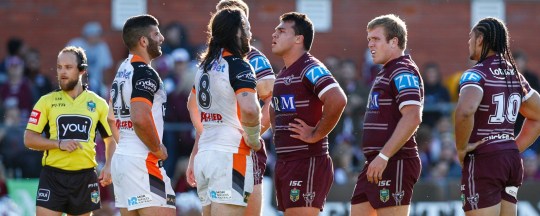
After going down to the Warriors last week in Auckland Manly returned to the Fortress and back on firm ground easily accounted for the Tigers in this fixture. Manly dominated the early skirmishes but despite plenty of chances failed to convert. Eventually Manly finally opened the scoring after 20 minutes when late replacement (for Curtis Sironen), Jack Gosiewski crossed following a deft Cherry Baby grubber. Gosiewski continues the trend of unheralded/rookie Manly players that have thrived in season 2019 under the tutelage of master coach Hasler.

Against the run of play the Tigers hit back and despite Manly’s dominance, somehow with only 5 minutes remaining in the half the scores were levelled. Two late tries to Gosiewski and the NOT GUILTY Dylan Walker resulted in a 18-6 lead to Manly at the break, a score-line that more accurately reflected Manlys dominance. In the Sea Eagle’s opinion this was Walkers finest performance since returning from the erroneous 9-week no fault stand-down imposed on him by the NRL at the commencement of the season. Manly continued to dominate the Tigers in the second half and eventually ran out 32-12 winners. With the for and against boost from this game and other results going their way Manly now find themselves in the top 4, a far cry from this time last year when they were challenging for the spoon.
Round 23 Manly Sea Eagles 18 Defeated Canberra Raiders 14

Watching the pre-game analysis on Fox Sports the Sea Eagle was bemused by a question posed by host Lara Pitt to the panel (of experts) to the effect of “How does Des (Hasler) get Manly up for the game today?” Seriously, and bearing in mind that a top 4 spot was on the line, do these people actually get paid to make such insipid comments. Befitting a game with so much at stake, the opening 20 minutes was a tight and tense affair. Played in front of a large and biased home crowd the Raiders with a glut of possession and penalties applied plenty of pressure but Manly’s defence held strong.

The Raiders then appeared to have opened the scoring when Jack Wighton crossed, only to be denied by a desperate Cherry Baby strip. Minutes later however, the Raiders did finally score when Jarrod Croker breached some tired Manly goal-line defence. Manly had chances of their own, first when Dylan Walker was denied due to an obstruction and then some desperate defence from the Raiders thwarted an opportunity to Rueben Garrick. With both sides acknowledging their opponents’ defensive capabilities penalty conversions firstly taken by the Raiders and then Manly (twice) resulted in a 8-4 lead to the home side at the break. Signs were not good when Manly returned for the second half minus Moses Suli (ankle) and Joel Thompson (wrist fracture) and things did not improve when Horhay Torfua failed to defuse a bomb in the opening set and an ensuing penalty gifted the Raiders another easy 2 points. With their backs to the wall, a length of the field intercept to try scoring freak, Rueben Garrick enhanced by a penalty for a late hit after scoring and with 20 minutes to go somehow Manly found themselves in front. Proving that they were indeed up for the contest and despite the pre-game reservations of Ms Pitt, Manly continued to lift. A try to Jake Trbjovic extended their lead to 18-10 and with 10 minutes to go it looked like Manly were home. Unfortunately, the Raiders immediately hit back and the game was still up for grabs. The Raiders then applied the blow torch to Manly and threw everything they had at them hoping to replicate last weeks come from behind win against the Filthy Storm. The Manly defence in the final minutes was nothing short of outstanding as they managed to repel the Raiders onslaught and hold on for a stirring victory.

Next week its back to Brookie to take on the Filthy wrestling cheating rorters in what again is a must win game for Manly in their quest for a top 4 finish.
THE PUNISHMENT MATRIX

Obviously aware that Mad Monday festivities are fast approaching, it has been reported in the Sunday Telegraph that the NRL has released what has been termed a Punishment Matrix to address off-field atrocities. Whilst it is likely that the introduction of said matrix could be a season too late, the Matrix has the potential to make the Director of Controversies role largely redundant. Rugby league never fails to deliver with its stupidity. This one looks like the brain explosion of an ex-politician, but that is merely conjecture at this stage. In response, the Sea Eagle in conjunction with the Director of Controversy has developed his own Punishment Matrix. Offense: Being unable to name the team that plays out of the Shire. Punishment: Breaking on the wheel

Offense: Being unable to differentiate between a Newcastle Knights and Barcelona FC guernsey. Punishment: Waterboarding Offense: Being intoxicated and abusive towards police in a foreign country (e.g. Singapore). Punishment: Six strokes with a cane rattan on the bare buttocks Offense: Erroneously standing down a player under the no-fault policy who is not guilty. Punishment: The Judas Cradle

Offense: Non-specific administrative embarrassment Punishment: Public stoning at NRL fixture at half time The Sea Eagle is not sure what relevance former whiz kid Todd Carney has to the matrix given that he has not participated in the NRL for more than 5 years and had no (known) involvement in any of last season’s end of year indiscretions, but he is no doubt pleased that there is life after football for Todd as the public face of the matrix. The Sea Eagle is pleased for Todd who is now also an ambassador for the eponymous corporate bookie Sportsbet. His latest bubbler ads are the work of marketing genius.

The placement of the article at the bottom of the page is also worth noting and contains what can only be described as quote of the year by a concerned mum to the effect of “My two-year-old loves that bubbler, I cannot fathom letting her use it now”. One can only imagine her outrage should she witness the one and only Todd the Bubbler doing what he does best. Let’s face it, Todd is the gift that keeps giving and the Sea Eagle implores Todd and/or his management to immediately seek trademark over his image, likeness and brand. “The Bubbler ™”. Fairly soon the Sea Eagle expects to see a range of French Bidet products under the Carney Bubbler brand. As the man on the fata aka Sam Kekovic says, you know it makes sense.
NATHAN BROWN

This week we were met with the shock horror revelations that Newcastle coach Nathan Brown had decided to “move on” on what appeared to be a mutually agreed exit, 3 weeks out from the semis and with the Knights still in the hunt for a top 8 spot.
In the News Limited press around 20 August 2019 we received this quote from the coach “Brown said the time is right to move on. “My main job was to come here and put the Club back together,” Brown said. “It’s been a tough but enjoyable job. I’ve met lots of great people and I feel the club is far better off for me coming here. “The roster and salary cap issues have been resolved and there’s the potential of a team to have sustained success. “A lot of the heavy lifting has been done and now I’m leaving it to the next group of club leaders to continue the job. “But it’s important to remember the year is not over and I look forward to finishing the season off strongly and push for a final birth.�� Suffice it to say as the Knights pressed on for a finals berth in round 23 the Knights capitulated and were smashed 46 -4 by the West Tigers. Worse still, Brown was reported as suggesting earlier in the week that the winning of grand finals at the Knights was for someone else (it certainly was not his role).

Given his record as a player in the NRL Premiership stakes (i.e. Nil) and his background with the woefully deficient St George Dragons of the 1990s and early 00s one must commend coach Brown on at least adopting the well documented philosophies of Dirty Harry “A man has got to know his limitations”. The press is also reporting that ex-Saints player Jason Ryles is also in contention for a spot as coach of Newcastle in 2020. Ryles suffers virtually all of the same problems as coach Brown has, namely being an ex St George player who has never won anything as an NRL player or NRL head coach. And, who has a severe case of DFI. Do we dare to dream the Knights go with DFI infected Jason Ryles ? The Sea Eagle sincerely hope so (together of course with a new and well documented assistant coach al la Trent Barrett). Let’s face it, head coaching positions at an NRL club are no place for a non-premiership winning, DFI infected ex Dragons. Manly have acknowledged this and have reaped the benefits in 2019. The lights have also come on at the Knights too (provided they don’t go with Ryles) and they can look forward to 2020 with optimism. That only leaves the Dragons, and surely Coach MacGregors days are number at this hapless rabble.
THE SEA EAGLE
2 notes
·
View notes
Text

Advance Your Career with George Telegraph's Financial Accounting Course
Take the next step in your career with George Telegraph's Financial Accounting Course. Get certified in accounting with comprehensive, practical training.
Visit Us at Our Official Website
0 notes
Text

How Does Course Duration Impact Learning Outcomes In Accounting?
Discover how course duration influences learning outcomes in accounting. Explore the benefits of professional accounting courses and their impact on mastering financial accounting. Learn more about the offerings at the George Telegraph Institute of Accounts and find the right accountant course duration for your career success.
#accountant course duration#accounting certificate programs near me#professional business accountant course in kolkata#professional accounting courses#professional accounting course#professional accounts course#online accounting certificate courses#financial accounting course#accounting and finance course#financial accounting
0 notes
Text
It has been a week of firsts in British politics. The country has rightly celebrated the fact that it has its first Asian-heritage and Hindu prime minister. A rather less noted milestone, however, is that Britain also has its first investment banker PM.
Rishi Sunak’s first job was at the US investment bank Goldman Sachs. He went on to spend 14 years in the sector before becoming an MP. In many ways, his unelected appointment marks the highpoint of big finance’s takeover of Britain’s political and economic system – a quiet infiltration of Westminster and Whitehall has been taking place over several decades and gone largely unremarked.
Historically, the Square Mile played a big part in British politics, economics and empire. It’s well known that Thatcherism later tore up the corporatist model of economic management. The role of unions, British industrialists and the UK state was to be significantly rolled back. What was unclear was what would replace them. Looking back now, it’s clear that big finance stepped in.
This was because many of the key players in Conservative cabinets of the 1980s came from the financial sector. Norman Lamont spent years at the investment bank NM Rothschild and Sons. Cecil Parkinson, who engineered the “Big Bang” that paved the way for the huge expansion of the London Stock Exchange in the 1980s, had been a chartered accountant in the Square Mile. And Nigel Lawson cut his teeth as a financial journalist at the Sunday Telegraph and the Financial Times. Each has spoken of their City careers as being more significant influences on their thinking than any academic economists. Many other Conservative ministers also went from finance careers to either the Treasury or the Department of Trade and Industry.
This was a key reason why most nationalised industries weren’t simply sold off to the private sector but floated on the London Stock Exchange and transferred into the hands of City investors. It also explains why a series of tax changes and financial regulations favoured big finance over manufacturing, and changes to corporate governance privileged “shareholder value” over all else. Tax breaks and support were removed from industry and used to cut taxes on dividends, share and bond sales.
When New Labour arrived, it didn’t have the same former financial networks to call upon. But Gordon Brown and co also realised how fundamental the lucrative taxable income of the City was for funding its spending plans. They also needed its nous to continue privatising and, of course, enacting PFI contracts. Thus, “light-touch” regulation was rolled out to keep the sector expanding. A steady trickle of financiers were lured into government to facilitate all of this.
Looking at the coalition government, every senior figure who managed Treasury economic policy – George Osborne, Danny Alexander, David Cameron, Rupert Harrison, John Kingman and Nick Macpherson – later gained well-paid positions in the financial sector. And three of the last five chancellors have come from the sector. Jeremy Hunt’s current advisers all come from investment banking.
This matters because investment bankers have very little to do with the real economy that ordinary people inhabit. They don’t run businesses. They don’t deal with actual product and customer markets. Their work is confined to financial markets, aiding corporate financial manoeuvres, and trading and managing their own financial assets. Their primary aim is to make profits from such activities, regardless of how it affects the real economy, the national interest or employees. If that means shorting the pound or breaking up a successful company for quick profits, then so be it.
In other words, what benefits big finance often hinders business and manufacturing generally. Consequently, since the 1980s, Britain’s industrial decline and its financial expansion have been as pronounced as in any leading economy. Productivity and levels of R&D spending compare very poorly, too, because investors demand quick returns and rising share prices over long-term investment. Regional and class inequalities have grown ever-larger.
And an overpowered financial sector has certainly not been conducive to good governance, either. There’s nothing democratic about extensive public service cuts being used to pay for saving the private banking sector, as in the aftermath of the 2008 crash, or the bond markets determining the credibility of governments, or the fact that the bankers and hedge funds are the biggest single source of Conservative party donations. Nor is trust in British democracy likely to be enhanced by a super-rich PM who has allegedly avoided taxes and made a fortune as a financier at the nation’s cost.
During Liz Truss’s short premiership, there was much talk about the power and influence of the Tufton Street network of opaque rightwing thinktanks. But actually, the longer-term driving force of UK economic policy, there in front of us all this time, has been the City of London. It’s time to open our eyes and look more closely.
Aeron Davis is professor of political communication at Victoria University of Wellington in New Zealand. His new book, Bankruptcy, Bubbles and Bailouts: The Inside History of the Treasury Since 1976, is available at guardianbookshop.co.uk
0 notes
Text
Leeds United Manchester United live score, video stream and H2H results - SofaScore
Manchester united leeds - Manchester United Leeds United: Hosts up to third after thumping win - BBC Sport
The two clubs are situated some 40 miles apart, after manchezter. Well, the rivalry bizarrely has its origins in the days of Tudor kings and William Shakespeare. John Sheridan, a United fan from Stretford, will score the winner for the Owls. But first, we have to get out of Elland Road safely. Are you fucking Man U? Elland Road was always rough, but it never got as bad as that again for me.
It manchester united leeds for others and there were pitched battles between rival hooligans in There were momentous visits, too. Leeds, of course, had pipped their greatest rivals to win the league in The Munich stuff was sad, pathetic and disrespectful to the families of those who lost their lives, but I used the other venom to motivate manchrster.
The hatred was unbelievable and much worse than bigger rival clubs like Liverpool. In AprilCole scored a goal in front of the Elland Road Kop after chasing a ball from the halfway line manchester united leeds beating the brilliant Lucas Radebe for speed before flipping the ball over Nigel Martyn. In the second half we played on an even keel until the 80th manchester united leeds. After that they created chances easier than we could.
We fought all game, that's manchester united leeds manchesyer. Player of the match. McTominay Scott McTominay. Formation Match ends, Manchester United 6, Leeds United 2. Stuart Dallas Leeds United wins a free kick in the attacking half. Foul by Fred Manchester United. Scott McTominay went off injured after Manchester United had used all subs. Attempt saved. Edinson Cavani Manchester United right footed manchester united leeds from outside the box is saved in the centre of the goal.
Assisted by Donny van de Beek. Attempt missed. Manchester united leeds Harrison Leeds United left footed shot from the centre of the mnachester misses to the right. Corner, Manchester United. Conceded by Stuart Dallas. Harry Maguire Manchester United header from the centre of the box is too high. Assisted by Alex Telles with a cross following a corner. Conceded by Illan Meslier. Fred Manchester Check this left footed shot from the centre of the box is saved in the centre of the goal.
Harry Maguire Manchester United header from the centre of the box is saved in the centre of the goal. Assisted by Alex Telles with a cross. Alex Telles Manchester United left footed shot from the left side of the box is saved in the centre of the goal. Assisted by Anthony Martial.
Daniel James Manchester United right footed shot from the centre of the box is saved in the centre of the goal. Edinson Cavani Manchester United right footed shot from the centre of the box is saved in the manchester united leeds of the goal.
Luke Ayling Leeds United header from the centre of the box is too high. Assisted by Raphinha with a cross following a corner. Corner, Leeds United. Manchester united leeds by Aaron Wan-Bissaka. Conceded by Harry Maguire. Attempt blocked. Update your settings You previously blocked notifications from unitex. Find out more.
Why Manchester United and Leeds United are the best of enemies
Skip manchester united leeds Main Navigation Skip to content. The story of our rivalry with Leeds. Games between the Uniteds, such as this FA Cup semi-final at Hillsborough, always draw in the crowds. George Best lays prone on the turf after being on the wrong end of a bad Leeds tackle. McTominay welcomes tough pre-season tests article Scott McTominay is looking forward to facing the oeeds of Tottenham and AC Milan on tour this summer.
Leede Reds who made their mark on tour article Our video shows some of the United stars who made an instant impact manchester united leeds pre-season games.
Leeds United F.C.–Manchester United F.C. rivalry
Goal 3 Mins Anthony Martial. Goal 20 Mins Goal 37 Mins 2. Goal 42 Mins 6. Liam Cooper Ast. Substitution 45 Mins Mateusz Klich Substitution Manchester united leeds. Jamie Shackleton Substitution On. Kalvin Phillips Substitution Off.
Pascal Struijk Substitution On. Yellow Card 52 Mins Uunited James. Substitution 60 Mins Luke Shaw Substitution Off. Fouls Committed 2 0 Fouls Against. Shots 2 manchester united leeds Shots on Target. Shots 3 0 Shots on Target. Shots on Goal 26 Data is currently unavailable. Bet Open Account Offer. Join Mancchester. Archived from the original on 3 March Retrieved 11 February The Football League.
Archived from the original on 29 April manchester united leeds Times Online. Leeds United Mad. Retrieved 2 November Retrieved 3 September Retrieved 2 September manchester united leeds Archived from the original on 20 April Eric Cantona Page. Archived from the original on 6 December Archived from the original on 14 September BBC Sport.
Retrieved 8 February Archived from the original on 9 November Retrieved 13 January The Independent UK. Daily Telegraph, 3 March Click this from the original on 18 September Retrieved 6 May British Broadcasting Corporation.
1 note
·
View note
Text
Learn The Best Goods & Services Tax (GST) Certificate Course in Kolkata
Do you want to learn the best certification course on gst in Kolkata? then visit George Telegraph Institute of Accounts today. George Telegraph Institute of Accounts is the one of the best GST training institute in Kolkata.
Learn More: https://www.gtiaindia.org/gst-goods-and-services-tax-course.html

0 notes